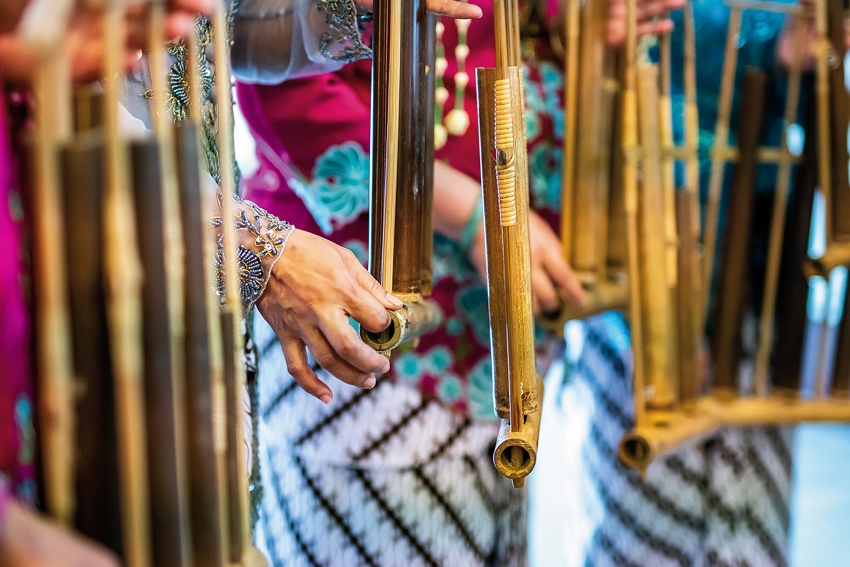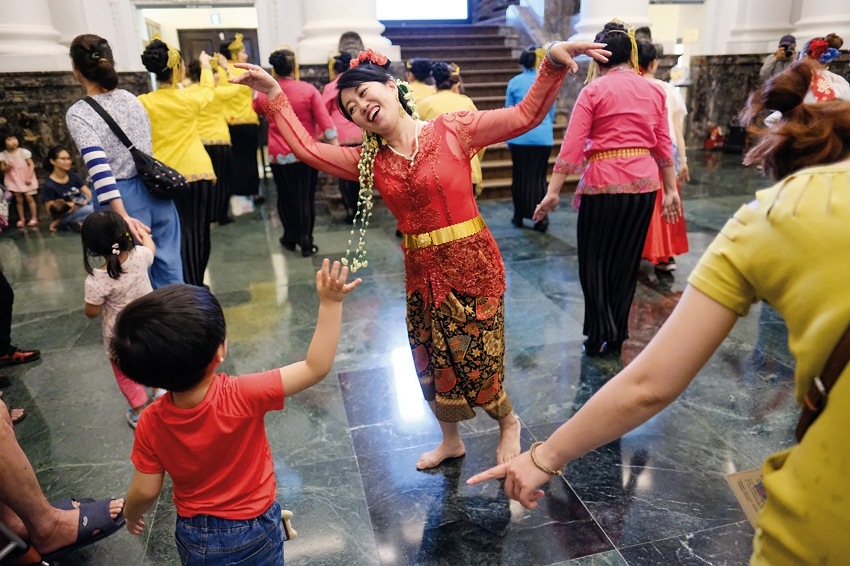
On May 18, International Museum Day, the National Taiwan Museum invited Gema Angklung to perform angklung music in their lobby. (photo by Chuang Kung-ju)

When performing, Gema Angklung wear batik clothing to match their Indonesian instruments. Their shows regularly attract large, enthusiastic crowds. (photo by Chuang Kung-ju)
Blessings of the rice goddess
“If asked which bamboo instrument has had the biggest impact on the world, I would answer without hesitation: the angklung.” So wrote Wang Wei, an expert on Chinese bamboo instruments, in his essay“Marvelous Bamboo Instruments, VI.” The angklung is a traditional percussion instrument made from bamboo that originated in western Java. It is popular in Indonesia, Malaysia, the Philippines, Singapore and other Southeast-Asian countries, where it has become a part of daily life. One can frequently hear it played during Eid al-Fitr (the festival marking the end of Ramadan) or to accompany the singing of hymns. Like Indonesian shadow-puppet theater and batik, the musical instrument has been listed by UNESCO as part of the “Intangible Cultural Heritage of Humanity.”
According to legend, the Sundanese people of Java experienced a famine in the 15th century and invented the angklung to perform for the harvest god, which caused the goddess of rice to descend among the people and provide them with abundant rice harvests. Consequently, the angklung has come to play an irreplaceable role in the harvest festival and is one of the most important instruments in traditional gamelan music.

Most of the group’s performers have multiple roles in life, not only carving out time from their work schedules for practices and performances but also frequently volunteering to assist new immigrants and engage in cultural exchange. (photo by Lin Min-hsuan)
Cultural exchange and memories of home
For members of Gema Angklung, the instrument carries memories of home and provides important opportunities for cultural exchange. They select the music to perform with care. Apart from having nostalgic feelings about Indonesian tunes, they also sprinkle in some familiar Mandarin, Taiwanese and Hakka tunes, leveraging music to reduce culture gaps.
Staples of the group’s performances include “Tanah Air” (“motherland”) and “Bengawan Solo” (“the banks of the Solo River”). “The Solo is the longest river on the island of Java, and it passes through some of the most prosperous areas of the nation,” says group leader Indra Tan. “The song is quite famous, and it has been sung in several languages, including Mandarin.”
Inclusive, accommodating, infectious and creative, music is like a river. Behind its melodies and beats are all manner of development paths, lifestyles, emotional needs and cultural histories. No members of the group had ever played the angklung in Indonesia. It wasn’t until they had immigrated to Taiwan that they began to learn how to produce sounds from its bamboo tubes.
“My mother was a teacher, and at church she would teach people how to play the angklung,” says Lily Lo, who joined the group last year. “But she wanted me to focus on my schoolwork and not spend any time learning how to play a musical instrument.” Explaining how postwar Indonesia didn’t stress cultural education, Fonny Zhang, an ethnic Chinese from Jakarta, notes, “In big families with many children, you were doing pretty well if you could buy enough food and send the kids to school.”

The angklung is a traditional percussion instrument made from bamboo that originated in western Java.
Meaningful lives
Members of the group hail from Jakarta, Surabaya and other places in Indonesia. Multitalented, they all wear multiple hats.
Indra Tan, the group leader and conductor, is an interpreter and guide at historic sites. She has founded musical groups and dance companies, and in 2017 she even cowrote songs with Black Hand Nakasi, a Taiwanese “workers’ band.” Expanding her realm beyond home and office, she has planted her feet into Taiwan’s public realm as the island has become her second homeland.
Kartika Condro Ester, the first in her family to go to college, studied in a STEM field and made a good income when she was working back in Indonesia. Her marriage to a man from Taiwan is what brought her here. To set an example to her own children, she insisted on pursuing another year of higher education in Taiwan. After passing the exam to serve as a legal interpreter, she provided the voiceover for a Ministry of Education video introducing Taipei’s “Indonesia Street.”
Fluent in English, Fonny Zhang is an editor of Indonesian mother-tongue educational materials at the Ministry of the Interior, and she often hosts foreign visitors. Cognizant of the importance of language skills, she has spoken Indonesian with her children since they were little. Her son Zheng Yaotian hasn’t disappointed her: After graduating from university he was posted abroad, where he has performed well on the job and earns over NT$1 million per year.
Mona Lin is a skilled chef and was once invited to the National Taiwan Museum to give a demonstration, where she showed how best to use spices and herbs such as sand ginger in downhome Indonesian cooking. A tireless learner, she is a licensed hair stylist. Every year she brings her children back to Indonesia to travel and visit relatives.
Gema Angklung has also brought in members of the next generation: Lin’s son Liu Huasheng has developed confidence by participating in the group and is determined to pursue a future in music, having enrolled in a performing arts program. The night before the junior-high general assessment exam, he still participated in a dress rehearsal, and right after finishing the exam he hurried to the National Taiwan Museum to give an outstanding performance. Formerly highly introverted, he has gradually gained confidence as he has matured. That has delighted his father to no end.

If music is like a conversation with pure sound, then physical language is a form of soundless communication. An important cultural feature of the nations of Southeast Asia is their rich traditions of music and dance.
Towards an integrated cultural identity
In the 18th century, when Jakarta’s ethnic Chinese community moved to Glodok, which is outside the old city, they began to play their traditional Chinese wind and stringed instruments in ensembles along with gambangs, which are traditional xylophone-like Indonesian instruments. They thus created what has become known as “gambang kromong” music. In the 200 years since, this kind of music has become a famous traditional art form in Jakarta and a symbol of multiculturalism for the whole Indonesian archipelago.
Today, the Indonesian government is interested in preserving its traditional arts and culture and in attracting the world to visit. In Java’s Jelekong “artists’ village,” one can see angklungs that artists have made themselves for sale in their street stalls. There are demonstrations of how to play them, and at scheduled times there are angklung concerts large and small. Everywhere there is joyous music.
Likewise, Gema Angklung is carrying the torch for traditional Indonesian culture in Taiwan by helping more people to become acquainted with the angklung and to gain a deeper understanding of Indonesia’s long history of moving music.











